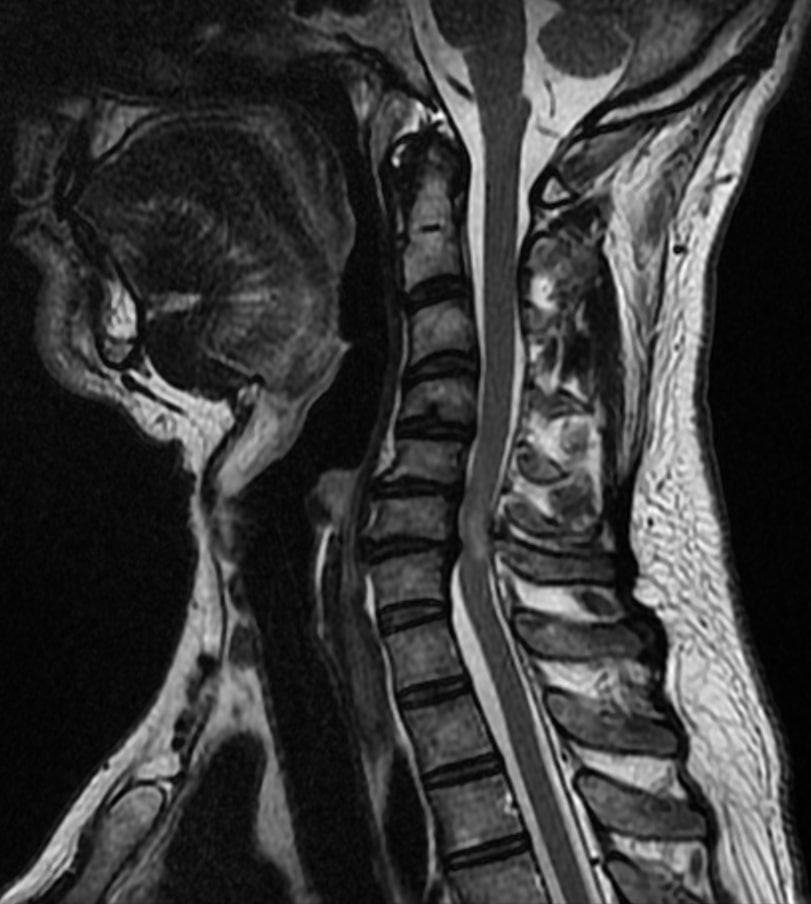Cervical Myelopathy

| |
| Cervical Myelopathy | |
|---|---|
| Clinical Features | lower motor neuron findings the level of the lesion and upper motor neuron findings below the level of the lesion |
Myelopathy is term that describes a spinal cord lesion that is confined to a discrete level, for example from trauma, tumour, or central disc protrusion. Symptoms and signs of myelopathy occur in the upper limbs, trunk, and lower limbs. The examination is used to determine whether long tract signs are present such as hyperreflexia, spasticity, and a positive Hoffman's sign. Patients may present with signs only in the upper limbs. There is the absence of lower motor neurone signs
Clinical Features
The lesion causes motor, sensory, and reflex abnormalities at the level of the lesion and below it. The weakness is of the lower motor neuron type at the level of the lesion (from damage to anterior horn cells and spinal roots), and of the upper motor neuron type below the level of the lesion (from damage to the descending upper motor neuron paths). An exception is that lesions at the foramen magnum and C3 to C4 can sometimes produce atrophy in the hands.
One needs to be familiar with the spinal innervation of the muscles. For example, in someone with a C7 segment spinal cord lesion, there is lower motor neuron weakness in the C7 muscles, but upper motor neuron weakness of the muscles below this level (e.g. in the lower limbs). The muscles from the segments above C7 are normal.
Gait may be disturbed with sensory ataxia due to a combination of proprioceptive defects, hypertonicity, and weakness.
There may be deep sensation defects in severe disease involving proprioception and vibration sense, due to posterior column compression.
Urinary incontinence can occur in long standing disease
Neck pain may be a feature but is not normally prominent, and does not tend to occur early unlike cervical radiculopathy
Special Tests
- Lhermittes sign (electric shock down torso on neck flexion)
- Foot tapping test
- Hand clenching test
- With back against the wall, unable to extend head back to touch the wall.
- Hoffman test, facilitated by cervical extension
Diagnosis
The following cluster of clinical features can be used to guide diagnostic reasoning.[1]
- Gait deviations
- Positive Hoffman’s
- Inverted supinator sign
- Positive Babinski
- Age >45 years
When 3/5 positive, then cervical myelopathy can be ruled in (+LR 30.9). When 1/5 positive, CSM could be ruled out (-LR 0.18)
Hoffman’s, Babinski, clonus and hyperreflexia are commonly used to rule out myelopathy. These tests by themselves demonstrate low sensitivity and are not appropriate for ruling out myelopathy
Imaging
MRI is best. Severe cord atrophy suggests a poor prognosis.
Differential Diagnosis
- Amyotrophic lateral sclerosis
- Multifocal motor neuropathy
- Multiple sclerosis
- Syringomyelia
- Peripheral neuropathy
Treatment
- Conservative
- Surgery
See Also
- ↑ Cook, Chad; Brown, Christopher; Isaacs, Robert; Roman, Matthew; Davis, Samuel; Richardson, William (2010-12). "Clustered clinical findings for diagnosis of cervical spine myelopathy". The Journal of Manual & Manipulative Therapy. 18 (4): 175–180. doi:10.1179/106698110X12804993427045. ISSN 2042-6186. PMC 3113267. PMID 22131790. Check date values in:
|date=(help)
Literature Review
- Reviews from the last 7 years: review articles, free review articles, systematic reviews, meta-analyses, NCBI Bookshelf
- Articles from all years: PubMed search, Google Scholar search.
- TRIP Database: clinical publications about evidence-based medicine.
- Other Wikis: Radiopaedia, Wikipedia Search, Wikipedia I Feel Lucky, Orthobullets,


